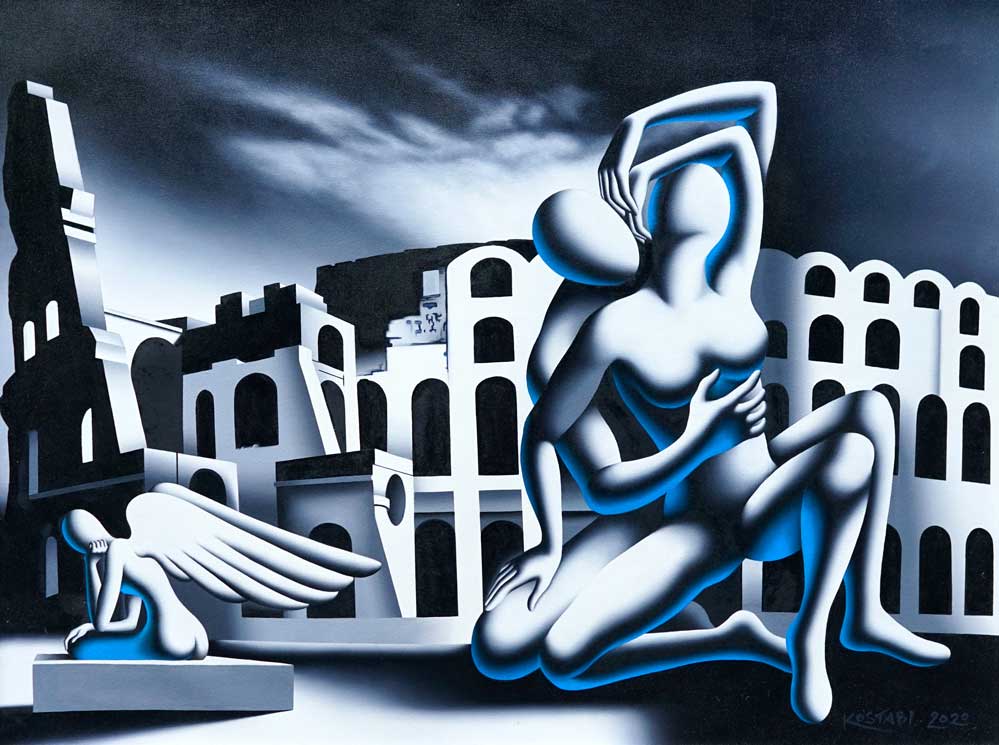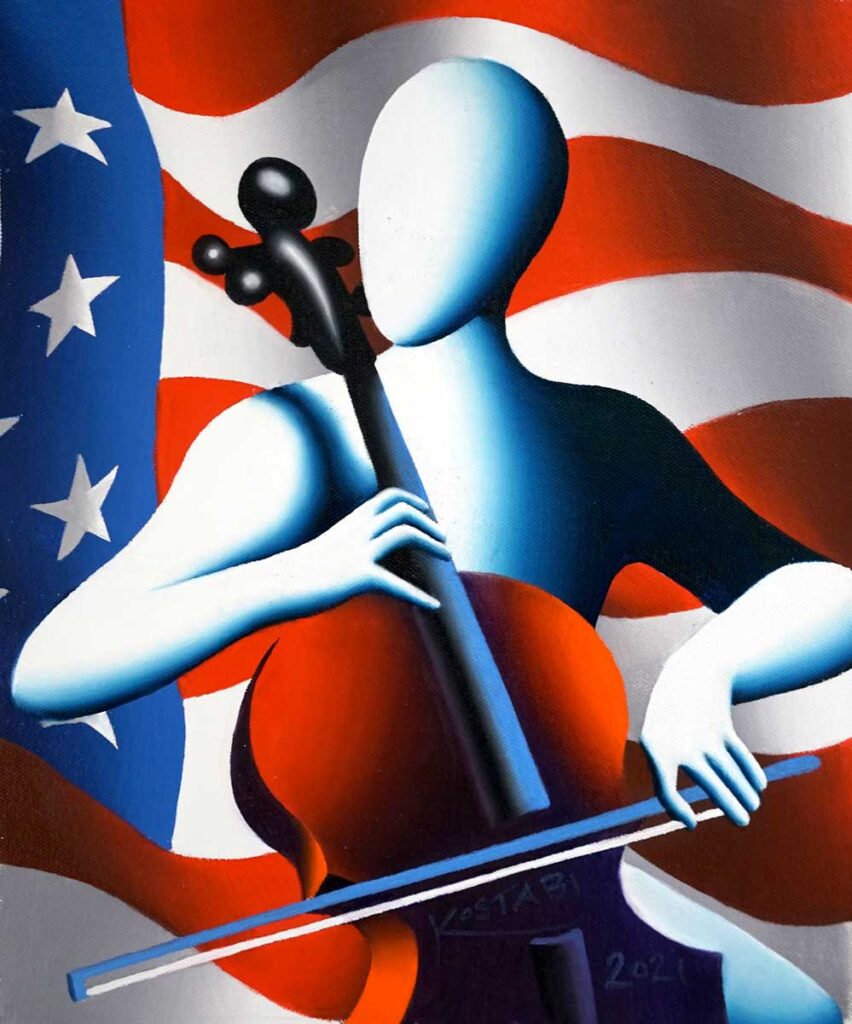
La prima volta che vidi un dipinto di Kostabi ne fui folgorato… Uno sfondo metafisico alla “De Chirico” con figure senza volto simili a quelle di Keith Haring, ma più armoniose, definite e soprattutto colorate. Conoscevo le sue opere con personaggi senza volto e per me lui era un artista senza volto. All’inizio della sua carriera era istrionico, capelli dalle tonalità punk, occhiali da sole e look anni ‘80, era quello che lui consiglia oggi “essere personaggio” : ogni suo passaggio è stato un tassello fondamentale nel percorso artistico che lo ha accompagnato per oltre 40 anni di attività.
Ad oggi è Kostabi l’artista in attività con la più alta produzione di opere d’arte, croce e delizia dell’artista, criticato e osannato allo stesso tempo (o lo ami o lo odi), in realtà le critiche arrivano da chi invidia il suo essere riuscito a coronare il sogno americano: “American Dream”, speranza che attraverso il duro lavoro e la determinazione sia possibile raggiungere un migliore tenore di vita e la prosperità economica, qualunque sia il punto di partenza.
Mark è un grande artista con spiccate doti creative e imprenditoriali, simpatico, saggio e dispensatore di consigli. Pochi sono gli artisti con tutte queste qualità. Ho avuto il piacere di incontrarlo nuovamente e poter fare due chiacchiere in tranquillità dopo questi mesi pandemici che hanno reso difficili i suoi soliti spostamenti tra New York e Roma, dove il suo spiccato senso estetico lo ha spinto verso una delle zone più belle della città eterna, a due passi dal Colosseo.
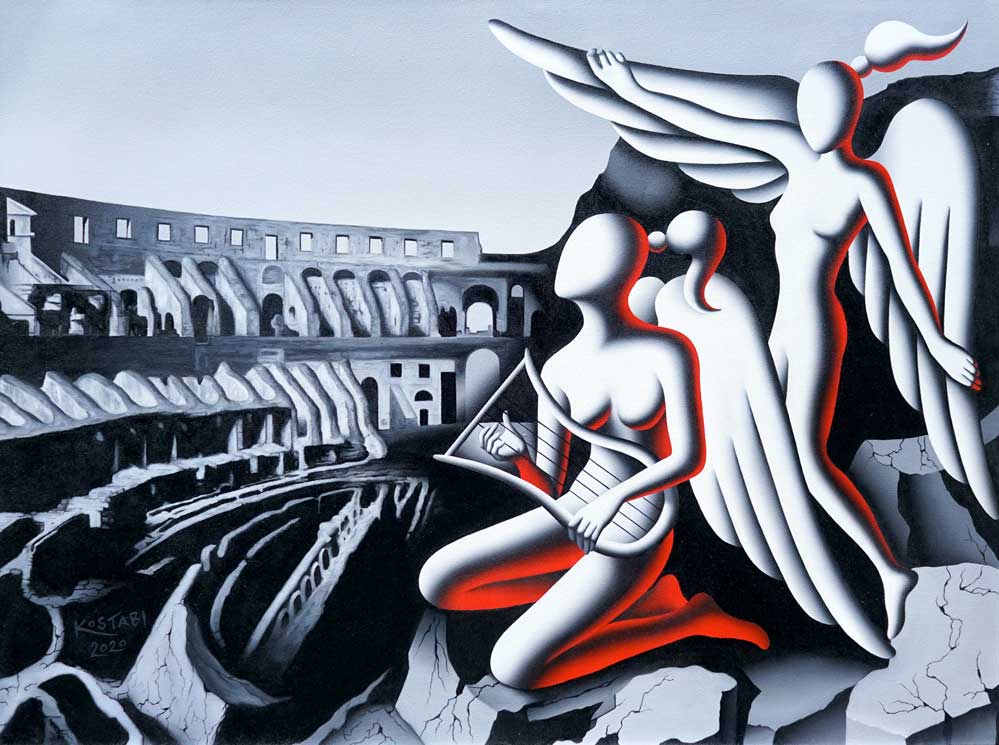
Vincenzo Chetta: Ciao Mark, come va? È un po’ che non ci vediamo, questa pandemia ha allontanato fisicamente tutti noi. Come è stato per te questo periodo, sia dal punto di vista artistico che dal punto di vista personale?
Mark Kostabi:Ciao Vincenzo, provo enorme empatia per tutti coloro che stanno soffrendo per la pandemia, ma sono al tempo stesso sollevato per la mia situazione: la mia vita, l’arte, la musica e gli affari sono fiorenti. Sono stato molto fortunato per non aver sofferto. Il mio unico disagio è dover indossare la mascherina, che è fastidiosa, ma necessaria per l’umanità. Sono stato vaccinato e non sento più il bisogno di indossare la mascherina, ma lo faccio per rispettare le regole. Artisticamente, sono stato più produttivo e ispirato che mai e sono felice che le vendite siano state buone! Ho una lunga lista d’attesa per i miei quadri.
V.C.: Ora fortunatamente ci sono i vaccini che ci semplificano un po’ le cose, in Italia per gli ingressi in Musei, fiere ed eventi è obbligatorio il green pass, tu come la pensi? Credi che sia il modo migliore per poter tenere aperti i luoghi di cultura?
M.K.: Sì, sono vaccinato e spero che tutti gli altri facciano lo stesso. Non ho paura dei vaccini e credo negli scienziati. Finora tutto quello che hanno detto si è sempre rivelato corretto. Hanno detto che in seguito dell’inoculazione ci sarebbe stato qualche disagio, e seppur lieve c’è stato, ma ora mi sento protetto, e in base alle statistiche lo sono. Conosco molte persone che sono no vax e quando chiedo loro perché, di solito dicono che hanno paura. Bene, io sono una delle tante prove che dimostrano che non c’è pericolo nel farsi vaccinare. Può solo aiutare, e lo farà…
V.C.: Torniamo in pieno a parlare d’arte. Mark, tu hai evoluto il concetto di ripetibilità, da non confondere con la ripetibilità dell’arte digitale, inserendo i tuoi soggetti in contesti differenti, anche traendo ispirazione tra grandi nomi del passato. Ci puoi spiegare come giochi sull’emotività del messaggio collocando in un contesto differente la stessa figura, ed ottenendo quindi un nuovo quadro ed una lettura completamente differente?
M.K.: Sto cercando di creare l’arte più interessante possibile. Voglio che la mia arte resista alla prova del tempo. Come l’opera dei pittori di Pompei prima dell’eruzione del Vesuvio. C’era un certo aspetto in tutti quei grandi affreschi. Voglio che i dipinti di Kostabi abbiano lo stesso status stilistico storico artistico, ma con un’ironia concettuale.
V.C.: Uno dei tuoi primi consigli (ne parlammo anche su Biancoscuro #18) è “Sii personaggio”. Warhol la parrucca, Dalì i baffi, tu sei riconosciuto anche perchè sei il primo artista con una batteria di artisti (finemente selezionati) che dipingono per te. All’inizio questa cosa ha fatto scandalo, poi il programma televisivo “Lifestyles of the Rich and Famous” ti ha dedicato una puntata. Avendo solo 6 collaboratori hai ben pensato di aggiungere amici al tuo staff per dare l’idea, durante le riprese, di avere una grossa factory ed è stata una mossa geniale poiché hai avuto un’enorme pubblicità per la tua arte e hai davvero potuto assumere più persone. Cosa vorresti rispondere ai tuoi haters?
M.K.: L’odio è la strada sbagliata e porta solo a più miseria per coloro che la scelgono. È meglio considerare la situazione degli altri che potenzialmente stai odiando. Anch’io sono stato tentato di odiare certe persone, ma è una perdita di tempo. Meglio dare l’esempio e ignorare gli haters o offrirsi di aiutarli pagando l’istruzione universitaria dei loro figli ad esempio.
V.C.: Ultimamente ho letto questo tuo pensiero su Facebook: “Circa 15 anni fa, un ex-mercante d’arte arrabbiato dell’East Village (che mi deve ancora 150 dollari) mi urlò contro nel ristorante Pink Pony su Ludlow Street, dicendo: “Non sei un artista! Sei solo un businessman!”. Oggi, un ex critico d’arte di Brooklyn, ora con sede in Canada, mi ha inviato un messaggio che dice: “Hai fatto i soldi come una persona d’affari. Non sei rispettato come artista”. Questo tuo post ha generato molte reazioni e molti commenti su Facebook e si ricollega alla mia introduzione. Io vedo il gallerista invidioso del tuo successo, ed il critico invece cerca solo di smontarti definendoti “artista non rispettato”, qual’è il tuo parere?
M.K.: Purtroppo questi atteggiamenti persistono. Molte persone sprecano il loro tempo ad attaccare gli altri invece di essere proattive nel migliorare la propria vita. Questa dinamica autodistruttiva è incoraggiata dal fatto che i profitti dei media formano raccontando storie di conflitto. Lavoro e mi batto per il giorno in cui l’umanità scoprirà che siamo tutti alla stessa cena e tutti brindiamo: “Alla vita!”
V.C.: Tu affermi che molti artisti parlano troppo e non ascoltano niente, lo ritengo davvero appropriato, alcuni artisti hanno un ego enorme, ma se ciò da un lato è bene, dall’altro questa incapacità di ascolto fossilizza la loro carriera. Anche a te è capitato di conoscere dei bravissimi artisti che non hanno avuto successo per la loro mente chiusa?
M.K.: Avere un enorme ego è una cosa positiva per un artista. Il rischio sta nel vantarsi di quell’ego in modo poco attraente. L’umiltà è attraente, ma non devi apparire debole. La cosa migliore è sapere che sei il migliore, dentro di te, ma non vantartene pubblicamente. Parla di te solo quando ti viene chiesto.
V.C.: Ho visto su YouTube un video della TEDx Talks dove esponi i tuoi preziosi consigli per gli artisti (vedere anche Biancoscuro #18) in quell’occasione ne hai aggiunti ancora 2 molto preziosi: “Credi in te stesso” e “Non dimenticarti degli amici”…
M.K.: Sì, credo davvero in queste due regole aggiuntive, meno aggressive. Sono molto grato a tutti i miei amici che mi hanno aiutato lungo la strada: Gino Natoni, Gene Luntz, Paul Kostabi, Walter Robinson, Lisa Rosen, Gene Pritsker, Paul Bridgewater, Molly Barnes, Don Lagerberg, Enrico Baj, Tony Esposito, Lucio Dalla, Heidi Follin, Wilfredo Arias, Shelly Fireman, Thomas McEvilley, George Segal, Suzanne Vega, Greesi Desiree Langovits e Ornette Coleman.
V.C.: Una tua grande mostra si è appena conclusa: “From Renoir to Kostabi”, Park West Museum, Honolulu, Hawaii, puoi darci qualche curiosità su questo evento?
M.K.: Ho avuto l’onore di lavorare con molte grandi gallerie, come Molly Barnes, Ronald Feldman, Larry Gagosian, Martin Lawrence Galleries, Semaphore, Stux, Gio Marconi, Studio d’Arte Raffaelli, Pio Monti, Guastalla, Galleria Mirò, Trifoglio Arte , Tri Art, Farina Art Group e molti altri, ma recentemente ho anche iniziato a lavorare con la Park West Gallery, famosa per aver operato su oltre 100 navi da crociera, aste di hotel e trasmissioni televisive. Hanno oltre 1.000 dipendenti e una vasta e interessante infrastruttura per vendere e consegnare arte a un pubblico molto più ampio, rispetto ai tradizionali canali di marketing artistico. Ora vendono regolarmente i miei dipinti per 150.000 dollari e oltre. Lavorare con Park West, da gennaio 2020, è stata un’avventura divertente, stimolante e redditizia nonostante gli ostacoli della pandemia.
V.C.: Fra le tue prossime mostre, ne terrai una a novembre al Kingston Pop Museum (Kingston, New York): “The Kostabi Brothers”, Puoi parlarci di questa mostra che farai con Paul?
M.K.: John Stavros è il direttore di quel museo. Amo Kingston! Uno dei miei migliori amici, il grande fotografo Jean Kallina, vive lì. Anche il grande bassista Tony Levin, con cui ho avuto l’onore di collaborare alla musica, vive a Kingston. John Stavros è stato ospite del mio game show, The Kostabi Show, un programma televisivo a New York in cui le celebrità competono per intitolare i miei quadri e ricevere premi in denaro. Da allora è diventato amico di mio fratello, Paul Kostabi, anche lui un artista con cui collaboro. Entrambi vivono a nord di Manhattan e in qualche modo questo spettacolo è nato. non vedo l’ora!
Anche Paul Kostabi ha recentemente iniziato a lavorare con la Park West Gallery, quindi aspettati più mostre museali per Paul e prezzi in rapido aumento! Magari anche una cover story di Biancoscuro!
V.C.: Avere Paul sulla Copertina di BIANCOSCURO sarà un grosso onore! È sempre un piacere parlare con te ed avere le tue opere sulle pagine di BIANCOSCURO. Siamo sempre felici del tempo trascorso a parlare di arte con te.
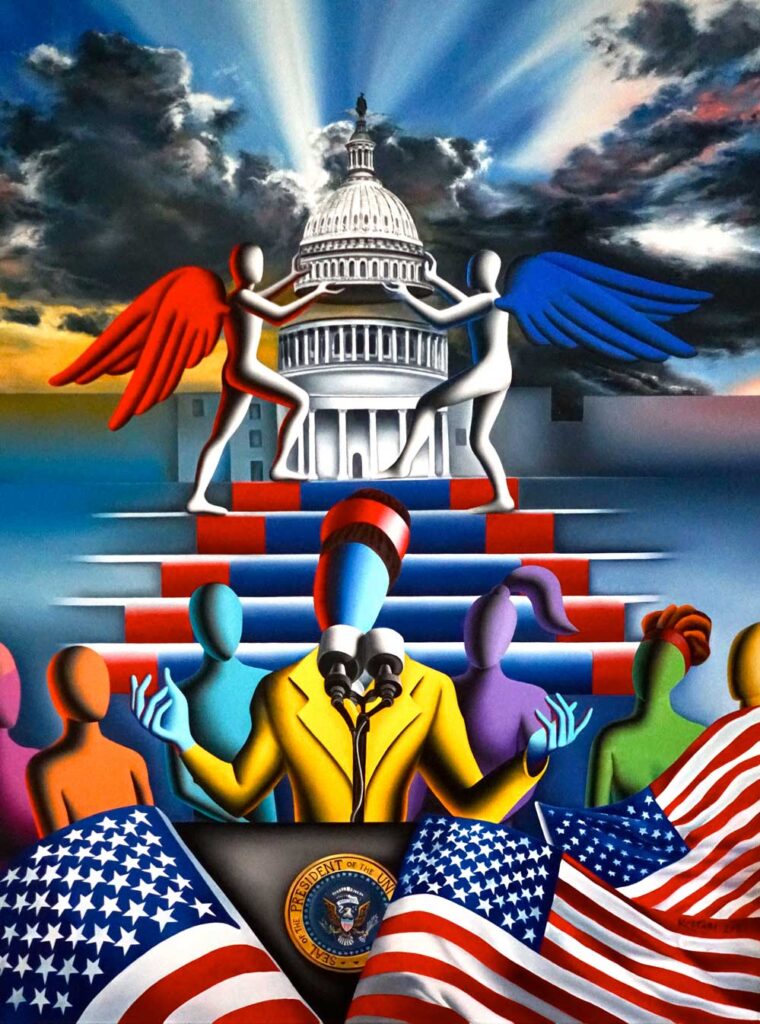
The first time I saw a painting by Kostabi I was struck by it… A metaphysical “De Chirico” background with faceless figures similar to those of Keith Haring, but more harmonious, defined and especially colorful. I knew his works of faceless characters and for me he was a faceless artist. At the beginning of his career he was histrionic, hair from punk shades, sunglasses and look 80s, was what he recommends today “be a character” : each step was a fundamental part of the artistic career that has accompanied him for over 40 years of activity.
Today Kostabi is the artist in activity with the highest production of works of art, “cross and delight of the artist”, criticized and acclaimed at the same time (or love or hate), in reality the criticism comes from those who envy his having succeeded in crowning the American dream, hope that through hard work and determination it will be possible to achieve a better standard of living and economic prosperity, whatever the starting point.
Mark is a great artist with strong creative and entrepreneurial skills, funny, wise and dispenser of advice. Few are the artists with all these qualities…
I had the pleasure of meeting him again and having a quiet chat after these pandemic months that have made difficult his usual commutes between New York and Rome, where the strong aesthetic sense of Kostabi pushed him towards one of the most beautiful areas of the eternal city, a stone’s throw from the Colosseum.
Vincenzo Chetta: Hi Mark, how’s it going? It’s been a while since we’ve seen each other, this pandemic has physically alienated all of us. How this period has been for you, both from the artistic point of view and from the personal point of view?
Mark Kostabi:I feel tremendous empathy for all those who are suffering and extremely grateful for my own situation: my life, art, music and business have been great, thriving. I am fortunate that I have not suffered. My only inconvenience is having to wear a mask, which is annoying, but necessary for humanity. I’ve been vaccinated (Pfizer) and don’t feel I need to wear the mask much anymore, but I do so to go along with the rules. (Third World problems.) Artistically I’ve been more productive and inspired than ever and I’m grateful that sales are so good! I have a long waiting list for my paintings.
V.C.: Now fortunately there are vaccines that simplify things a bit, in Italy for the entrance in museums, fairs and events is mandatory the green pass, you as you think, you think it is the best way to keep open places of culture?
M.K.: Yes, I’m vaccinated and I hope everyone else does the same. I have no fear of the vaccines. I believe in the scientists. So far everything they said was correct. They said there would be some discomfort for about 3 days after every shot, and there was. But now I feel protected, and based on statistics, I am. I know a lot of people who are anti-vax and when I ask them why, they usually say they’re afraid. Well, I am one of many millions of reasons to prove why there is no danger in getting vaccinated. It can only help, and it will.
V.C.: Let’s get back to art. Mark, you have evolved the concept of repeatability, not to be confused with the repeatability of digital art, inserting your subjects in different contexts, even drawing inspiration from the big names of the past… Can you explain how you play on the emotionality of the message by placing the same figure in a different context, and thus obtaining a new picture and a completely different reading?
M.K.: I’m basically trying to create the most interesting art possible. I want my art to stand the test of time. Like the work of painters of Pompeii before the Vesuvius eruption. There was a certain look to all those great frescoes. I want Kostabi paintings to have that same art historical stylistic status, but with conceptual irony.
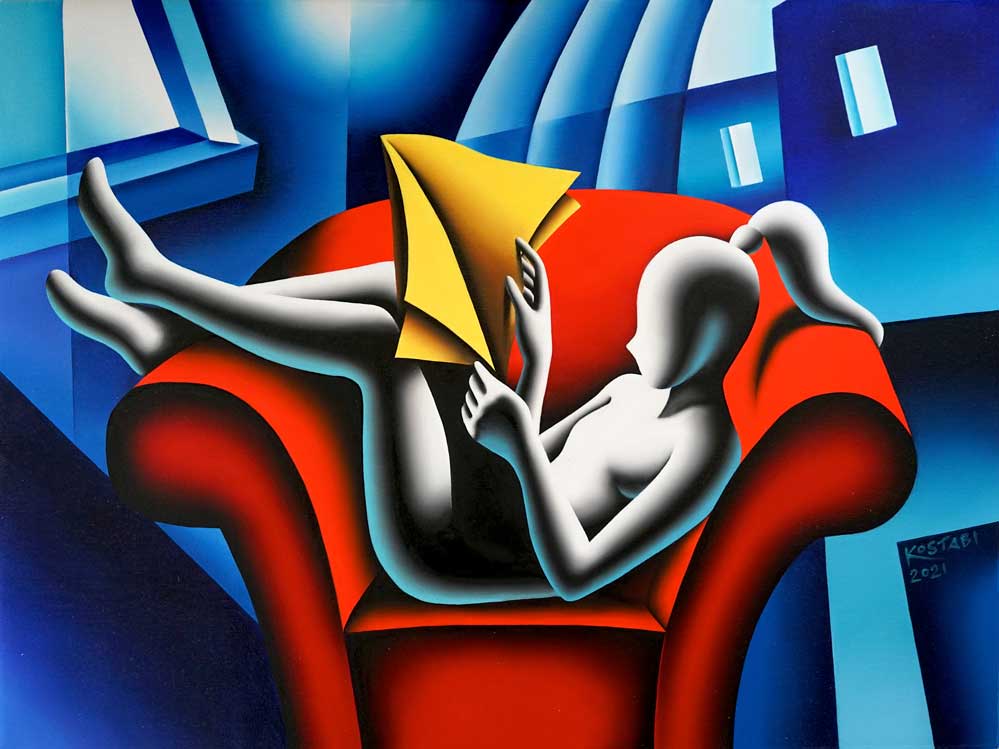
V.C.: One of your first tips (we also talked about it in Biancoscuro #18) is “Be a character”. Warhol the wig, Dalì the moustache, you are recognized also because you are the first artist with a battery of artists (finely selected) who paint for you. At first this thing made a scandal, then “Lifestyles of the Rich and Famous” dedicated an episode to you. Having only 6 collaborators you thought well to add friends to your staff to give the idea, during the shooting, to have a big factory and it was a brilliant move because you had a huge publicity for your art and you really could hire more people. What would you like to answer to your haters?
M.K.: Hating is the wrong street and only leads to more misery for those who choose it. It’s better to consider the situation of the others who you are potentially hating. I too have been tempted to hate certain people, but it’s a waste of time. Better to lead by example and ignore the haters or offer to help pay for their kid’s college education.
V.C.: I’ve been reading this on Facebook lately: ”About 15 years ago, an angry, ex-East Village art dealer (who still owes me $150) yelled at me in the Pink Pony restaurant on Ludlow Street, saying: “You’re not an artist! You’re just a businessman!”.
Today, an ex-Brooklyn based art critic, now based in Canada, sent me a message saying: “You made money as a business person. You are not respected as an artist.”
This post has generated many reactions and many comments on Facebook and relates to my introduction. I see the gallerist envious of your success, and the critic instead just tries to disassemble you calling you “unfulfilled artist”, what’s your opinion?
M.K.:Unfortunately these attitudes persist. Many people waste their time attacking others instead of being proactive in improving their own lives. This self-destructive dynamic is encouraged by the fact that the media profits form telling tales of conflict. I work for the day that humanity learns that we’re all at the same dinner party and we all toast: “To life!”
V.C.: You say that many artists talk too much and don’t listen to anything, I think it is really appropriate, some artists have huge egos, but if this is good on the one hand, on the other this listening capacity fossilizes their career. You too happened to know some very good artists who were not successful for their closed mind?
M.K.: Having an enormous ego is a positive thing for an artist to have. The risk lies in boasting about that ego in an unappealing way. Humility is appealing, but you must not appear weak. The best thing is to know you’re the best ,within yourself, but not to brag about it publicly. Only speak about yourself when you’re asked to.
V.C.: I saw on Youtube a video of Tedx Talks where you expose your valuable tips for artists (see also Biancoscuro #18) on that occasion you added 2 very precious: “Believe in yourself” and “Don’t forget friends”…
M.K.: Sì, Yes, I truly believe in these two additional, less aggressive rules. I’m so grateful for all my friends who have helped me along the way: Gino Natoni, Gene Luntz, Paul Kostabi, Walter Robinson, Lisa Rosen, Gene Pritsker, Paul Bridgewater, Molly Barnes, Don Lagerberg, Enrico Baj, Tony Esposito, Lucio Dalla, Heidi Follin, Wilfredo Arias, Shelly Fireman, Thomas McEvilley, George Segal, Suzanne Vega, Greesi Desiree Langovits and Ornette Coleman.
V.C.: A great exhibition of yours has just ended: “From Renoir to Kostabi”, Park West Museum, Honolulu, Hawaii, can you give us some curiosity about this event?
M.K.: I’ve had the honor to work with many great galleries, like Molly Barnes, Ronald Feldman, Larry Gagosian, Martin Lawrence Galleries, Semaphore, Stux, Gio Marconi, Studio d’Arte Raffaelli, Pio Monti, Guastalla, Galleria Mirò, Trifoglio Arte, Tri Art, Farina Art Group and many others, but recently I’ve also started working with Park West Gallery, famous for operating on over 100 cruise ships, hotel auctions and telecasts. They have over 1,000 employees and a vast, interesting infrastructure for selling and delivering art to a much wider public, compared to traditional channels of art marketing. They are now routinely selling my paintings for $150,000 and more. It’s been a fun, inspiring and profitable adventure, working with Park West, since January 2020 – despite the obstacles of the pandemic.
V.C.: Among your next exhibitions, you’ll have one in November at Kingston Pop Museum (Kingston, New York): “The Kostabi Brothers”, Can you tell us about this show you’re doing with Paul??
M.K.:John Stavros is the director of that museum. I love Kingston! One of my best friends, the great photographer Jean Kallina, lives there. Also the great bassist Tony Levin, who I’ve had the honor to collaborate with on music, lives in Kingston. John Stavros was a guest on my game show, The Kostabi Show, a TV show in New York where celebrities compete to title my paintings for cash awards. Since then, he became friends with my brother, Paul Kostabi, also an artist who I collaborate with. They both live north of Manhattan and somehow this show came to be. I can’t wait!
Paul Kostabi has also recently started working with Park West Gallery, so expect more museum shows for Paul and rapidly rising prices! Maybe even a Biancoscuro cover story!
V.C.: Thank you Mark, of course, having Paul as Biancoscuro cover story will be a big honor! It is always a pleasure to talk to you and have your works on BIANCOSCURO pages. We are always happy with the time spent talking about art with you.
